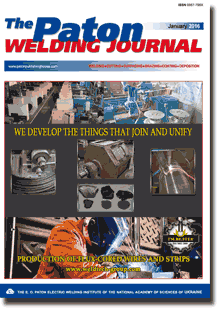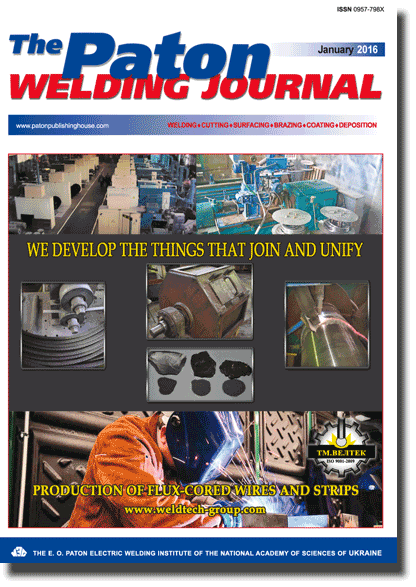| 2016 №01 (01) |
DOI of Article 10.15407/tpwj2016.01.02 |
2016 №01 (03) |

The Paton Welding Journal, 2016, #1, 12-16 pages
Modelling of chemical composition of weld pool metal in arc methods of welding
V.V. Golovko And L.A. Taraborkin
E.O. Paton Electric Welding Institute, NASU 11 Kazimir Malevich Str., 03680, Kiev, Ukraine. E-mail: office@paton.kiev.ua
Abstract
Development of complex calculation algorithm based on system approach for numerical prediction of formation and growth of non-metallic inclusions in a weld metal is one of the important tasks in present time. One of significant blocks of it is a calculation estimation of weld metal chemical composition in arc methods of welding, which is of interest and being studied in present work. A procedure was proposed for calculation of content of weld pool melt in arc welding. The developed procedure is based on modelling of thermodynamics of interface interaction in metal–slag–gas-vapor phase system in a temperature range typical for weld pool existence in arc methods of welding. Predicted content of metal melt can be a basis for modelling of content, size, morphology and chemical composition of non-metallic inclusions in weld metal. 11 Ref., 3 Tables, 3 Figures.
Keywords: arc welding, weld pool, melt, thermodynamics, inclusions, slag, chemical composition, modelling, prediction
Received: 27.10.15
Published: 15.03.16
References
- Weng, Y. (2003) Microstructure refinement of structural steel in China. ISIJ Int., 43(11), 1675–1682. https://doi.org/10.2355/isijinternational.43.1675
- Borovikov, A.V. (2003) Production of straight-seam large-diameter pipes made of steel of strength class X80. Metallurgist, Vol. 47, 9–10. https://doi.org/10.1023/B:MELL.0000015274.80337.3b
- Kim, Y.M., Kim, S.K., Lim, Y.J. et al. (2002) Effect of microstructure on the yield ratio and low temperature toughness of line pipe steels. ISIJ Int., 42(12), 1571–1577. https://doi.org/10.2355/isijinternational.42.1571
- Shukla, R., Das, S.K., Kumar, B.R. et al. (2012) Ultra-low carbon, thermomechanically controlled processed microalloyed steel: microstructure and mechanical properties. and Mater. Transact. A, 43(12), 4835–4845. https://doi.org/10.1007/s11661-012-1273-7
- Park, J.S., Lee, C., Park, J.H. (2012) Effect of complex inclusion particles on the solidification structure of Fe–Ni–Mn–Mo alloy. Ibid., B, 43(12), 1550–1557. https://doi.org/10.1007/s11663-012-9734-3
- Sarma, D.C., Karasev, A.V., Jonson, P.G. (2009) On the role of nonmetallic inclusions in the nucleation of acicular ferrite in steels. ISIJ Int., 49(7), 1063–1074. https://doi.org/10.2355/isijinternational.49.1063
- Babu, S.S. (2009) Thermodynamic and kinetic models for describing microstructure evolution during joining of metals and alloys. Materials Rev., 6, 333–367. https://doi.org/10.1179/095066009X12506720908654
- Zinngrebe, E., Van Hoek, C., Visser, H. et al. (2012) Inclusion population evolution in Ti-alloyed Al-killed steel during secondary steelmaking process. ISIJ Int., 52(1), 52–61. https://doi.org/10.2355/isijinternational.52.52
- Jung In-Ho, Decretov, S.A., Pelton, A.D. (2004) Computer application of thermodynamic databases to inclusion engineering. Ibid., 44(3), 527–536.
- Grigoryan, V.A., Stomakhin, A.Ya., Ponomarenko, A.G. (1989) Physical-chemical calculations of electric steelmaking processes. Moscow: Metallurgiya.
- CHEMICAL WORKBENCH v 3.5: Description of reactor models. (2007) Moscow: Kinetic Technologies.
Suggested Citation
V.V. Golovko And L.A. Taraborkin (2016) Modelling of chemical composition of weld pool metal in arc methods of welding. The Paton Welding J., 01, 12-16.The cost of subscription/purchase order journals or individual articles
| Journal/Currency | Annual Set | 1 issue printed |
1 issue |
one article |
| TPWJ/USD | 384 $ | 32 $ | 26 $ | 13 $ |
| TPWJ/EUR | 348 € | 29 € | 24 € | 12 € |
| TPWJ/UAH | 7200 UAH | 600 UAH | 600 UAH | 280 UAH |
| AS/UAH | 1800 UAH | 300 UAH | 300 UAH | 150 UAH |
| AS/USD | 192 $ | 32 $ | 26 $ | 13 $ |
| AS/EUR | 180 € | 30 € | 25 € | 12 € |
| SEM/UAH | 1200 UAH | 300 UAH | 300 UAH | 150 UAH |
| SEM/USD | 128 $ | 32 $ | 26 $ | 13 $ |
| SEM/EUR | 120 € | 30 € | 25 € | 12 € |
| TDNK/UAH | 1200 UAH | 300 UAH | 300 UAH | 150 UAH |
| TDNK/USD | 128 $ | 32 $ | 26 $ | 13 $ |
| TDNK/EUR | 120 € | 30 € | 25 € | 15 € |
AS = «Automatic Welding» - 6 issues per year;
TPWJ = «PATON WELDING JOURNAL» - 12 issues per year;
SEM = «Electrometallurgy Today» - 4 issues per year;
TDNK = «Technical Diagnostics and Non-Destructive Testing» - 4 issues per year.


